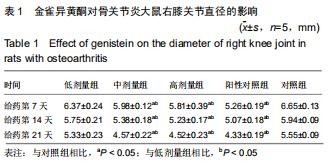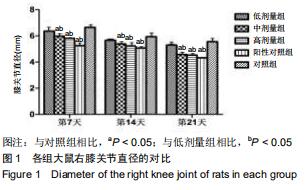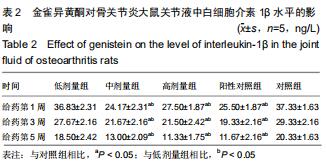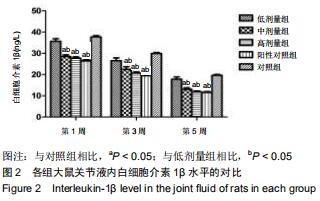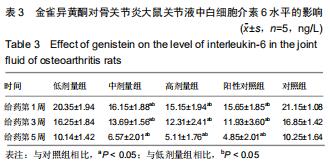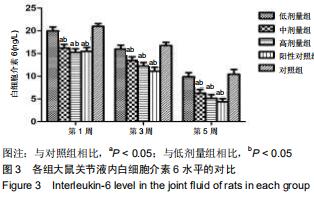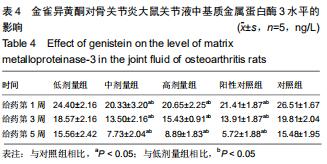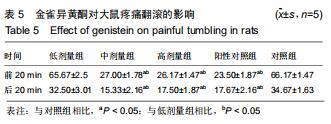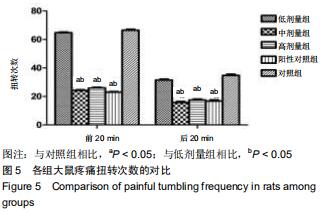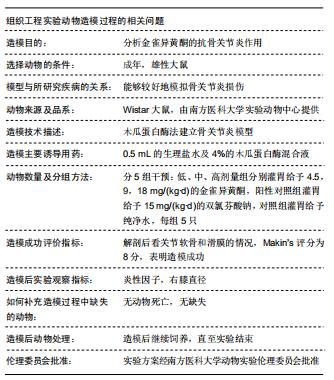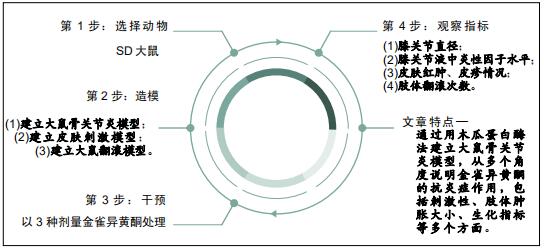中国组织工程研究 ›› 2020, Vol. 24 ›› Issue (35): 5607-5612.doi: 10.3969/j.issn.2095-4344.2920
• 骨组织构建 bone tissue construction • 上一篇 下一篇
不同剂量金雀异黄酮对骨关节炎模型大鼠关节疼痛、炎症的抑制作用
曾小云,张丽容
深圳市龙华区人民医院全科,广东省深圳市 518109
Inhibitory effects of different doses of genistein on joint pain and inflammation in osteoarthritis model rats
Zeng Xiaoyun, Zhang Lirong
General Department of People’s Hospital of Longhua District, Shenzhen 518109, Guangdong Province, China
摘要:
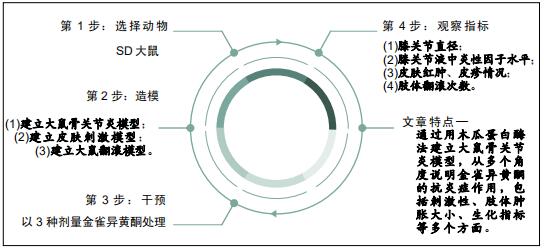
文题释义:
金雀异黄酮:又称染料木素,是一种多酚类化合物,来源于大豆和红三叶草等植物,分子结构与17β-雌二醇类似,因其对雌激素受体有高度亲和力而被认为是植物雌激素,具有抗氧化能力,可抑制酪氨酸蛋白激酶活性,具有诱发细胞凋亡、增加抗癌效果、抑制血管生成等作用。同时它也是类黄酮中的一种,因此常被称为大豆异黄酮,目前被认为是一种有潜力的癌症预防化合物,在预防癌症方面有显著作用。
Wistar大鼠:是大鼠中的一种,1907年由美国维斯塔尔(Wistar)研究所养育成,现已是世界各国实验室中常见的大鼠,也是中国使用最广泛、用量最大的一种大鼠,其主要的特点是:头宽耳长,尾长度小于身长;繁殖力强,产仔多,生长发育快;性情温顺;抗传染病能力强;自发性肿瘤发生率低。
背景:金雀异黄酮是一种大豆制品衍生物,具有预防骨质疏松和抑制癌症的作用,其对骨关节炎的作用目前尚无相关报道。
目的:分析不同剂量金雀异黄酮对骨关节炎的效果并探讨其机制。
方法:采用木瓜蛋白酶法建立雄性Wistar大鼠右膝骨关节炎模型,分5组干预:低、中、高剂量组分别灌胃给予4.5,9,18 mg/(kg·d)的金雀异黄酮,阳性对照组灌胃给予15 mg/(kg·d)的双氯芬酸钠,对照组灌胃给予纯净水,连续给药35 d。给药后第7,14,21天检测右膝膝关节直径;给药后第1,3,5周检测右膝关节液中炎性因子水平。分别于雄性Wistar大鼠皮肤表面涂纯净水、金雀异黄酮胶体和0.8%甲醛,建立皮肤刺激模型,观察皮肤出现红肿及皮疹情况。采用醋酸法建立雄性Wistar大鼠疼痛翻滚模型,醋酸注射3 min后分组干预,干预方式同骨关节模型,记录前20 min与后20 min大鼠肢体翻滚次数,判断止痛效果。实验方案经南方医科大学动物实验伦理委员会批准。
结果与结论:①相同时间点内,中、高剂量组与阳性对照组膝关节直径小于对照组(P < 0.05),前3组间比较差异无显著性意义(P > 0.05);②相同时间点内,中、高剂量组与阳性对照组基质金属蛋白酶3、白细胞介素6、白细胞介素1β水平均低于对照组(P < 0.05),前3组间比较差异无显著性意义(P > 0.05);③金雀异黄酮凝胶涂于大鼠皮肤表面后皮肤无皮疹及红肿;④前20 min与后20 min内,9,18 mg/kg的金雀异黄酮可缓解大鼠疼痛,其止痛效果和双氯芬酸钠无明显差别;⑤结果表明,金雀异黄酮对皮肤无刺激性,在一定剂量范围内具有止痛、抗炎、消肿和抗骨关节炎的功效。
ORCID: 0000-0002-8891-7977(曾小云)
中国组织工程研究杂志出版内容重点:组织构建;骨细胞;软骨细胞;细胞培养;成纤维细胞;血管内皮细胞;骨质疏松;组织工程
中图分类号:
